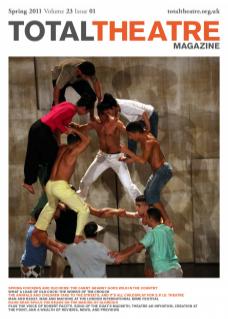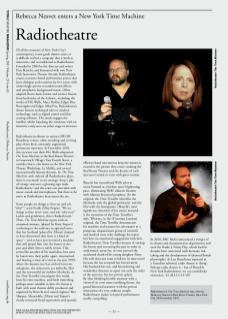Of all the treasures of New York City’s contemporary avant-garde theatre scene, it is difficult to find a company that is both as innovative and as traditional as Radiotheatre. Founded in 2004 by the director and writer Dan Bianchi, and honoured with two New York Innovative Theater Awards, Radiotheatre creates narrative-based performance pieces that layer dialogue and narration by live actors with unnervingly precise recorded sound effects, and symphonic background music. Often adapted from classic horror and science fiction from both sides of the Atlantic, including the works of HG Wells, Mary Shelley, Edgar Rice Burroughs and Edgar Allan Poe, Radiotheatre’s shows harness archetypal tales to modern technology, such as digital sound and film-scoring software. The result engages the intellect whilst hijacking the emotions with an intensity rarely seen on either stage or airwaves.
Radiotheatre performs in various Off-Off-Broadway venues, often retooling and reviving plays from their constantly augmented permanent repertory. In December 2010, this reviewer saw their HG Wells adaptation The Time Machine at the Red Room Theater in Greenwich Village’s East Fourth Street, a corridor that is also home to the New York Theatre Workshop, La MaMa, and several internationally famous theatres. In The Time Machine, and, indeed, all Radiotheatre plays, there is not much to see onstage. Atop a pile of vintage suitcases, a glowing sign reads ‘Radiotheatre’ and the actors are provided with music stands and microphones. But there is far more to Radiotheatre than meets the eye.
‘Some people see things as they are and ask “why?”,’ actor Frank Zilinyi begins. ‘We see things as they never were, and ask “why not?” Ladies and gentlemen, this is Radiotheatre.’ Then, The Time Machine opens with an unnamed woman, (played by Katie Siepert) confessing to the audience in agitated tones that her husband (played by Zilinyi) claimed to have discovered that ‘time is a kind of space’ – and to have just invented a machine that will propel him into the future or the past and allow him to safely return. This seems like another of his mad ideas, but soon he bursts into their parlor again, traumatised and bearing a story of a visit to the year 5959, where the human race has evolved into two subspecies, the aristocratic yet imbecilic Eloi and the resourceful yet ruthless Morlocks. As the Time Traveller investigates this world, loses his time machine, and finds something perhaps more valuable to him, the future is built with aural themes deftly produced and organised by Bianchi and sound engineer Wes Shippee. Meanwhile, Zilinyi and Siepert’s clearly conveyed facial expressions and sparsely efficient hand movements keep the narrators rooted in the picture they create, making the Red Room Theater and the theatre of each spectator’s mind co-exist with great tension.
Bianchi has streamlined Wells’ plot to move forward at a brisker, more frightening pace, eliminating Wells’ didactic fixation with Marxist historical prophecy. (In the original, the Time Traveller identifies the Morlocks with the global proletariat, and the Eloi with the bourgeoisie.) Bianchi’s most significant alteration of his source material is the invention of the Time Traveller’s wife. Whereas, in the (Victorian London) original, the Time Traveller demonstrates his machine and narrates his adventures to a pompous, dispassionate group of scientific and medical men, who challenge his report but have no emotional engagement with him, Radiotheatre’s Time Traveller dreams of visiting the future and recreating the past in order to understand, atone for, or even prevent the accidental death of his young daughter Mary. His wife does not want to believe in time travel because she has accepted her bereavement. Her husband has not, and his tinkering and wanderlust threaten to upset not only the order of the universe, but her private sphere. By thus blending horrific memory with a vision of an even more terrifying future, the grand historical narrative with the private interaction of a very ordinary couple, Radiotheatre makes its layered performance totally compelling.
In 2010, BBC Radio announced a merger of its drama and documentaries departments and axed the Radio 4 Friday Play, which had for decades been associated with thematic risk-taking and the development of talented British playwrights. As Leo Benedictus reported in a Guardian editorial, radio theatre is ‘dying’. Perhaps radio theatre is – but of Bianchi’s New York Radiotheatre, we can confidently announce, ‘it’s ALI-I-I-I-I-VE!’
Radiotheatre’s The Time Machine was seen by Rebecca Nesvet at Red Room Theater, New York City, 28 December 2010.

